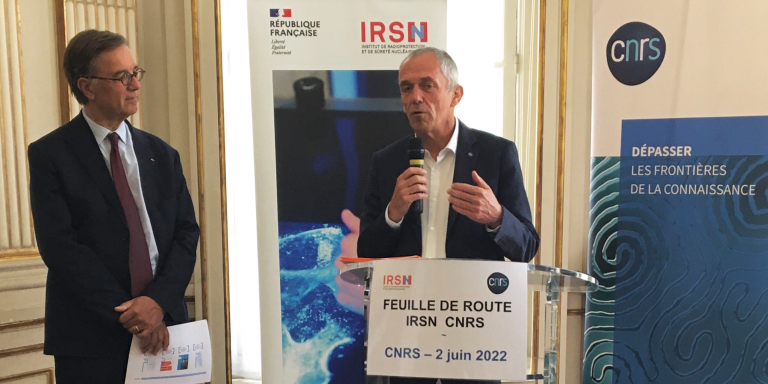
CNRS and the Institut de Radioprotection et de Sûreté Nucléaire (IRSN) have long cooperated in the field of nuclear safety. In 2008, they created a joint laboratory, MIST (Laboratoire de Micromécanique et Intégrité des Structures), to study the thermomechanical behavior of materials subjected to harmful environments such as nuclear fuels. On June 2, the two organizations drew up a joint roadmap specifying the themes and scientific questions that will structure their partnership.
The IRSN is a public industrial and commercial institution under the joint authority of the Minister of the Environment, the Minister of Defense, and the Ministers of Energy, Research, and Health. It is the national public expert on nuclear and radiological risks, and contributes to public policies on nuclear safety and the protection of health and the environment from ionizing radiation. Its expert assessment and research missions cover the following fields
- Radiological monitoring of the environment and response to radiological emergencies,
- Radiation protection of humans,
- Prevention of major accidents in nuclear facilities,
- Reactor safety,
- Safety of plants, laboratories, transport and waste,
- Nuclear defense expertise.
The six themes of the joint IRSN-CNRS roadmap
The development of this joint roadmap, which reflects the desire of IRSN and CNRS to strengthen a partnership based on their respective strategic objectives, involved the three IRSN research units (safety, environment and health) and five of the ten CNRS institutes: IN2P3, INC, INSIS, INSU and INEE.
Fanny Farget, coordinator of the CNRS contribution while she was deputy scientific director at IN2P3, said:
“The work done illustrates the ability of this partnership to stimulate interdisciplinarity and to broadly mobilize CNRS expertise to solve concrete scientific questions.”
The roadmap specifies the themes and scientific questions on which the two organizations have decided to collaborate following the renewal of their framework agreement in November 2020, namely:
- Alteration of materials, components and structures,
- Earthquakes and soil-structure interactions,
- Transversal in-situ research in the field of the environment,
- New nuclear techniques for health,
- Sensors and metrology,
- Software platforms and simulation.
Nuclear power, an important lever for the energy transition
Although considered as an important lever for the energy transition, nuclear power is the subject of many debates and faces major challenges. As part of their partnership, CNRS and IRSN have decided to strengthen their work on a key issue in the extension of the operating life of reactors: that of materials and their deterioration.
The roadmap thus aims to improve the ability to predict the behavior of steels and composite materials over time and for environmental conditions specific to nuclear facilities.
Assessing the seismic risk in France
IRSN and CNRS will also continue their collaboration to assess the seismic risk in mainland France. They will address the many scientific questions raised by the Le Teil earthquake that struck the Montélimar region in November 2019. This historically unprecedented magnitude 5 earthquake was characterized by scientists from the CNRS, IRSN, IRD, the universities of Montpellier and Côte d’Azur, and the company Terradue, using the technological tools of seismology, geodesy and geology. Due to the reactivation of an ancient fault, it raised the problem of the seismic resistance of nuclear power plants.
They will also work to strengthen the dialogue between geosciences and engineering sciences with a view to improving the consideration of interactions between soils and structures in vulnerability studies.
Assessing the effects of radioactivity and acquiring new data
CNRS and IRSN also plan to collaborate in the field of environmental sciences to assess the effects of radioactivity on ecosystems and socio-ecosystems, and will support the development of new nuclear technologies in the medical field.
In addition to these areas of collaboration, there are two others of a more transverse nature.
- Sensors, measurements and their processing.
CNRS and IRSN want to take advantage of technological advances and the contributions of AI to make progress in all the research fields in which they collaborate, thus gaining access to new ways of observing, measuring, acquiring data and deriving information from them.
- The second concerns scientific modeling codes and platforms.
In this field, IRSN and CNRS will work to reproduce the phenomena and situations that are characteristic of the operation of nuclear facilities, by improving multiphysics couplings and using advanced numerical methods.
Didier Gay, deputy director of strategy, responsible for scientific affairs, at IRSN, states:
“On all of these topics, CNRS and IRSN want their partnership to lead to effective collaborations and productive dialogue between their research teams.”
IRSN and CNRS have also chosen to place their partnership under the banner of environmental and climate responsibility.
Antoine Petit, CEO at CNRS, concludes:
“I am delighted with this structuring collaboration for CNRS and IRSN, which will mobilize their expertise on key societal issues through this partnership. Mobilizing the full potential of science to control nuclear and radiological risks and help meet the challenges of energy and health is the ambition of the roadmap that CNRS and IRSN have just established.
Translated from Sûreté nucléaire : l’IRSN et le CNRS présentent leur feuille de route commune









